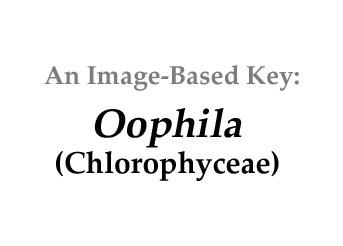|
Home / Chlorophyceae / Unicells / Non-flagellated / Oophila |
|
||||
|
|||||
|
|||||
|
|||||
|
|||||
|
|
|||||
|
|||||
|
Click on images for larger format |
|
||||
Name derivation: |
|
||||
|
‘Egg
lover’ |
|
||||
Classification: |
|
||||
|
Oophila F.D. Lambert ex N. Wille, 1909, the single species description is currently
accepted taxonomically (guiry and Guiry 2014). |
|
||||
Morphology: |
|
||||
|
Spherical
non-flagellated green cells embedded within eggs of amphibians (see below). |
|
||||
Similar genera: |
|
||||
|
|
|
||||
Habitat: |
|
||||
|
Symbiotic,
living in the gelatinous envelope of the salamander, Ambystoma maculatum,
and in the tree frog, Rana sylvatica (Hutchison
and Hammen 1958). Presence of a
population of Oophila sp. decreases
mortality rate of eggs, increases growth rate, promotes an earlier time of
hatching with larger embryos (Gilbert 1942, 1944). Apparently the accelerated vertebrate embryonic growth
rate can be attributed to the PS supply of oxygen, as well as the removal of
waste ammonia. Complimentary
work has documented a higher respiratory rate in the embryos (Hutchison and
Hammen 1958). Later work indicated
that local oxygen production in the egg envelope was essential to larval
development because oxygen diffusion from surrounding water was insufficient
(Pinder and Friet 1994). Even in the presence of O. amblystomatis, eggs of A. maculatum are subjected to periodic
anoxia at night (Halls and Mills 2007). I have also seen but not looked carefully
at green insect masses deposited unerwater by dragonflies, and suspect Oophila may be
present there also. The dragonflies are the Libellulidae, with perhaps the most
common genera Libulla
and Sympetrum
in the Northern Hemisphere and Trithemis
and Zenithoptera
-- certainly the most beautiful -- in the Southern Hemisphere. Nonflagellated
spherical Unicelled. Symbiotic with salamander eggs. The salamander eggs
produce more nitrogen for the algae while the algae produce more oxygen for
the eggs. Oophila
F.D.Lambert ex N.Wille 1909;
the single species description is currently accepted taxonomically
(Guiry and Guiry 2013).
Order
Chlamydomonadales; Family Chlorococcaceae
|
|
||||
|
|||||
References: |
|
||||
|
Gilbert,
P.W. 1942. Observations on the eggs of Ambystoma maculatum with special
reference to the green algae found within the egg envelopes. Ecol. 23:215-227. Gilbert,
P.W. 1944. The Alga-Egg Relationship in Ambystoma
maculatum, A Case of Symbiosis. Ecol. 25: 366-369 Guiry, M.D. and G.M. Guiry 2013.
AlgaeBase.
World-wide electronic publication, National University of Ireland, Galway.
http://www.algaebase.org; searched on 15 October 2012. Halls,
J.H., and N.E. Mills 2007.
Intermittent hypoxia in eggs of Ambystoma
maculatum: embryonic development and egg capsule
conductance. J. Exp. Biol.
210:2430-2435. Hunter,
T and S. Vogel 1986. Spinning Embryos Enhance Diffusion Through Gelatinous
Egg Masses. J. Exper. Marine Biol. and Ecol. 96: 303-308. Hutchison,
V.H., and C.S. Hammen 1958. Oxygen utilization in the symbiosis of embryos of
the salamander, Ambystoma maculatum
and the alga, Oophila ambylstomatis. The Biol. Bull. 115:483-489. Mills
NE, M.C. Barnhart, and R.D. Semlitsch 2001. Effects of hypoxia on egg capsule
conductance in Ambystoma (Class
Amphibia, Order Caudata). J. of Exper. Biol. 204: 3747-3753. Pinder,
A.W., and S.C. Friet 1994. Oxygen transport in egg masses of the
amphibians Rana sylvatica and Ambystoma maculatum. Convection, diffusion and oxygen production
by algae. J. Exp. Biol. 197:17-30. Wille, N. 1909. VII. Abteiling.
Chlorophyceae. In: Syllabus
der pflanzenfamilien 6. (Engler, A. Eds) Berlin. |
|
||||

